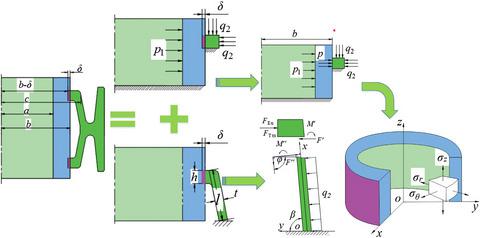当前位置:
X-MOL 学术
›
Energy Sci. Eng.
›
论文详情
Our official English website, www.x-mol.net, welcomes your
feedback! (Note: you will need to create a separate account there.)
Contact mechanical behaviors of radial metal seal for the interval control valve in intelligent well: Modeling and theoretical study
Energy Science & Engineering ( IF 3.5 ) Pub Date : 2019-12-22 , DOI: 10.1002/ese3.597 Yiwei Yang 1, 2 , Hongwu Zhu 1 , Dongsheng He 2 , Changcheng Du 2 , Liangbin Xu 3 , Yufa He 3 , Yan Zheng 2 , Zhewei Ye 2
Energy Science & Engineering ( IF 3.5 ) Pub Date : 2019-12-22 , DOI: 10.1002/ese3.597 Yiwei Yang 1, 2 , Hongwu Zhu 1 , Dongsheng He 2 , Changcheng Du 2 , Liangbin Xu 3 , Yufa He 3 , Yan Zheng 2 , Zhewei Ye 2
Affiliation

|
Intelligent wells equipped with the interval control valve (ICV), which have the potential applications to significantly improve oil production or control the water production of wells and fields, are more and more widely utilized in the oilfields. The radial metal seal of an ICV is intended to isolate the flow of produced fluids between the casing annulus and the well tubing. The contact mechanical behaviors of the radial metal seal are essential to the structural design and reliability of ICVs in the intelligent well. In this paper, the two‐dimensional axisymmetric assembly of the radial metal seal and the closure member is abstracted as a combination of interference fit model and cantilever beam model. Based on that, the related theoretical model, between the radial metal seal's contact stress and its independent variables, has been derived. Next, numerically simulations of contact stress between the radial metal seal and the closure member for different independent variables are conducted by the finite element method (FEM) to validate the theoretical model. It is found that the mean absolute value of relative error between the numerical and theoretical results of the contact stress is approximately 10%. Additionally, the structural parameters of the radial metal seal are proposed with the absolute value of relative error <10%. Furthermore, the value of the contact stress based on the cantilever beam model can be used to calculate an approximation theoretical solution. In summary, the proposed theoretical model provides a foundation for the design, improvement, and selection of radial metal seal under the known oilfield conditions.
中文翻译:

智能井中间隔控制阀径向金属密封的接触力学行为:建模与理论研究
装备有间隔控制阀(ICV)的智能井在油田中得到了广泛应用,这些井具有显着提高油田产量或控制井和田产水量的潜在应用。ICV的径向金属密封件旨在隔离套管环空和井管之间的采出液流。径向金属密封件的接触机械性能对于智能井中ICV的结构设计和可靠性至关重要。本文将径向金属密封件和封闭件的二维轴对称组件抽象为干涉配合模型和悬臂梁模型的组合。在此基础上,推导了径向金属密封件的接触应力与其自变量之间的相关理论模型。接下来,通过有限元方法(FEM)进行了径向金属密封件和封闭件之间不同自变量的接触应力的数值模拟,以验证理论模型。发现接触应力的数值和理论结果之间的相对误差的平均绝对值约为10%。另外,提出了径向金属密封件的结构参数,相对误差的绝对值<10%。此外,基于悬臂梁模型的接触应力值可用于计算近似理论解。总之,所提出的理论模型为已知油田条件下径向金属密封的设计,改进和选择提供了基础。通过有限元方法(FEM)对径向金属密封件与封闭件之间的接触应力进行了数值模拟,以验证该理论模型的正确性。发现接触应力的数值和理论结果之间的相对误差的平均绝对值约为10%。另外,提出了径向金属密封件的结构参数,相对误差的绝对值<10%。此外,基于悬臂梁模型的接触应力值可用于计算近似理论解。总之,所提出的理论模型为已知油田条件下径向金属密封的设计,改进和选择提供了基础。通过有限元方法(FEM)对径向金属密封件与封闭件之间的接触应力进行了数值模拟,以验证该理论模型的正确性。发现接触应力的数值和理论结果之间的相对误差的平均绝对值约为10%。另外,提出了径向金属密封件的结构参数,相对误差的绝对值<10%。此外,基于悬臂梁模型的接触应力值可用于计算近似理论解。总之,所提出的理论模型为已知油田条件下径向金属密封的设计,改进和选择提供了基础。
更新日期:2019-12-22
中文翻译:

智能井中间隔控制阀径向金属密封的接触力学行为:建模与理论研究
装备有间隔控制阀(ICV)的智能井在油田中得到了广泛应用,这些井具有显着提高油田产量或控制井和田产水量的潜在应用。ICV的径向金属密封件旨在隔离套管环空和井管之间的采出液流。径向金属密封件的接触机械性能对于智能井中ICV的结构设计和可靠性至关重要。本文将径向金属密封件和封闭件的二维轴对称组件抽象为干涉配合模型和悬臂梁模型的组合。在此基础上,推导了径向金属密封件的接触应力与其自变量之间的相关理论模型。接下来,通过有限元方法(FEM)进行了径向金属密封件和封闭件之间不同自变量的接触应力的数值模拟,以验证理论模型。发现接触应力的数值和理论结果之间的相对误差的平均绝对值约为10%。另外,提出了径向金属密封件的结构参数,相对误差的绝对值<10%。此外,基于悬臂梁模型的接触应力值可用于计算近似理论解。总之,所提出的理论模型为已知油田条件下径向金属密封的设计,改进和选择提供了基础。通过有限元方法(FEM)对径向金属密封件与封闭件之间的接触应力进行了数值模拟,以验证该理论模型的正确性。发现接触应力的数值和理论结果之间的相对误差的平均绝对值约为10%。另外,提出了径向金属密封件的结构参数,相对误差的绝对值<10%。此外,基于悬臂梁模型的接触应力值可用于计算近似理论解。总之,所提出的理论模型为已知油田条件下径向金属密封的设计,改进和选择提供了基础。通过有限元方法(FEM)对径向金属密封件与封闭件之间的接触应力进行了数值模拟,以验证该理论模型的正确性。发现接触应力的数值和理论结果之间的相对误差的平均绝对值约为10%。另外,提出了径向金属密封件的结构参数,相对误差的绝对值<10%。此外,基于悬臂梁模型的接触应力值可用于计算近似理论解。总之,所提出的理论模型为已知油田条件下径向金属密封的设计,改进和选择提供了基础。











































 京公网安备 11010802027423号
京公网安备 11010802027423号